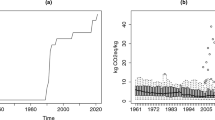Abstract
This paper describes the methodology of singular spectrum analysis (SSA) and demonstrate that it is a powerful method of time series analysis and forecasting, particulary for economic time series. The authors consider the application of SSA to the analysis and forecasting of the Iranian national accounts data as provided by the Central Bank of the Islamic Republic of Iran.
Similar content being viewed by others
References
S. D. Krane, An evaluation of real GDP forecasts: 1996–2001, Economic Perspectives, 2003, http://www.chicagofed.org/publications/economicperspectives/2003/1qeppart1.pdf.
L. Y. Cao and A. Soofi, Nonlinear deterministic forecasting of daily dollar exchange rates, International Journal of Forecasting, 1999, 15(4): 421–430.
A. Soofi and L. Y. Cao, Nonlinear Forecasting of Noisy Financial Data (ed. by Soofi and Cao), Modeling and Forecasting Financial Data: Techniques of Nonlinear Dynamics, Kluwer Academic Publishers, Boston, 2002.
D. A. Hsieh, Chaos and nonlinear dynamics: Application to financial markets, Journal of Finance, 1991, 46: 1839–1877.
J. Scheinkman and B. LeBaron, Nonlinear dynamics and stock returns, Journal of Business, 1989, 62: 311–337.
D. S. Broomhead and G. P. King, Extracting qualitative dynamics from experimental data, Physica D, 1986, 20: 217–236.
N. Golyandina, V. Nekrutkin, and A. Zhigljavsky, Analysis of Time Series Structure: SSA and Related Techniques, Chapman & Hall/CRC, New York-London, 2001.
D. Danilov and A. Zhigljavsky, Principal Components of Time Series: The `Caterpillar’ Method, University of St. Petersburg, St. Petersburg (In Russian), 1997.
J. B. Elsner and A. A. Tsonis, Singular Spectral Analysis, A New Tool in Time Series Analysis, Plenum Press, New York and London, 1996.
V. G. Moskvina and A. Zhigljavsky, An algorithm based on singular spectrum analysis for change-point detection, Communication in Statistics-Simulation and Computation, 2003, 32(4): 319–352.
H. Hassani, Singular spectrum analysis: Methodology and comparison, Journal of Data Science, 2007, 5(2): 239–257.
H. Hassani, S. Heravi, and A. Zhigljavsky, Forecasting European industrial production with singular spectrum analysis, International Journal of Forecasting, 2009, 25: 103–118.
Th. Alexandrov and N. Golyandina, The automatic extraction of time series trend and periodical components with the help of the Caterpillar-SSA approach, Exponenta Pro. 3–4 (In Russian), 2004, 54–61.
S. L. Marple-Jr, Digital Spectral Analysis, Prentice Hall, New Jersey, 1987.
M. Bouvet and H. Clergeot, Eigen and singular value decomposition technique for the solution of harmonic retrieval problems, in SVD and Signal Processing: Algorithm, Applications and Architectures (Ed. by E. F. Deprettere ), North-Holland, Amsterdam, 1988, 93–114.
V. K. Madisetti and E. Lloyd, The Digital Signal Processing Handbook, CRC Press, Boca Raton, 1998.
D. Brillinger, Time Series, Data Analysis, and Theory, Holt, Rinehart and Winston, Inc., New York, 1975.
T. Subba Rao, Canonical factor analysis and stationary time series models. Sankhya: The Indian Journal of Statistics, 1976, 38B: 256–271.
T. Subba Rao and M. M. Gaber, An Introduction to Bispectral Analysis and Bilinear Time Series Models, Speringer-Verlag, 1984.
URL: http://www.cbi.ir.
B. Efron and R. Tibshirani, Bootstrap methods for standard error, confidence intervals and other measures of statistical accuracy, Statist. Science, 1986, 1(1): 54–75.
URL: http://www.cardiff.ac.uk/maths/subsites/stats/changepoint/index.html.
F. X. Diebold and R. S. Mariano, Comparing predictive accuracy, Journal of Business, Economics and Statistics, 1995, 13: 253–263.
Author information
Authors and Affiliations
Corresponding author
Additional information
This research was in part supported by a grant (No. 88/121230) from Institute for Trade Studies and Research (ITSR), Tehran, Iran.
Rights and permissions
About this article
Cite this article
Hassani, H., Zhigljavsky, A. Singular spectrum analysis: methodology and application to economics data. J Syst Sci Complex 22, 372–394 (2009). https://doi.org/10.1007/s11424-009-9171-9
Received:
Revised:
Published:
Issue Date:
DOI: https://doi.org/10.1007/s11424-009-9171-9




